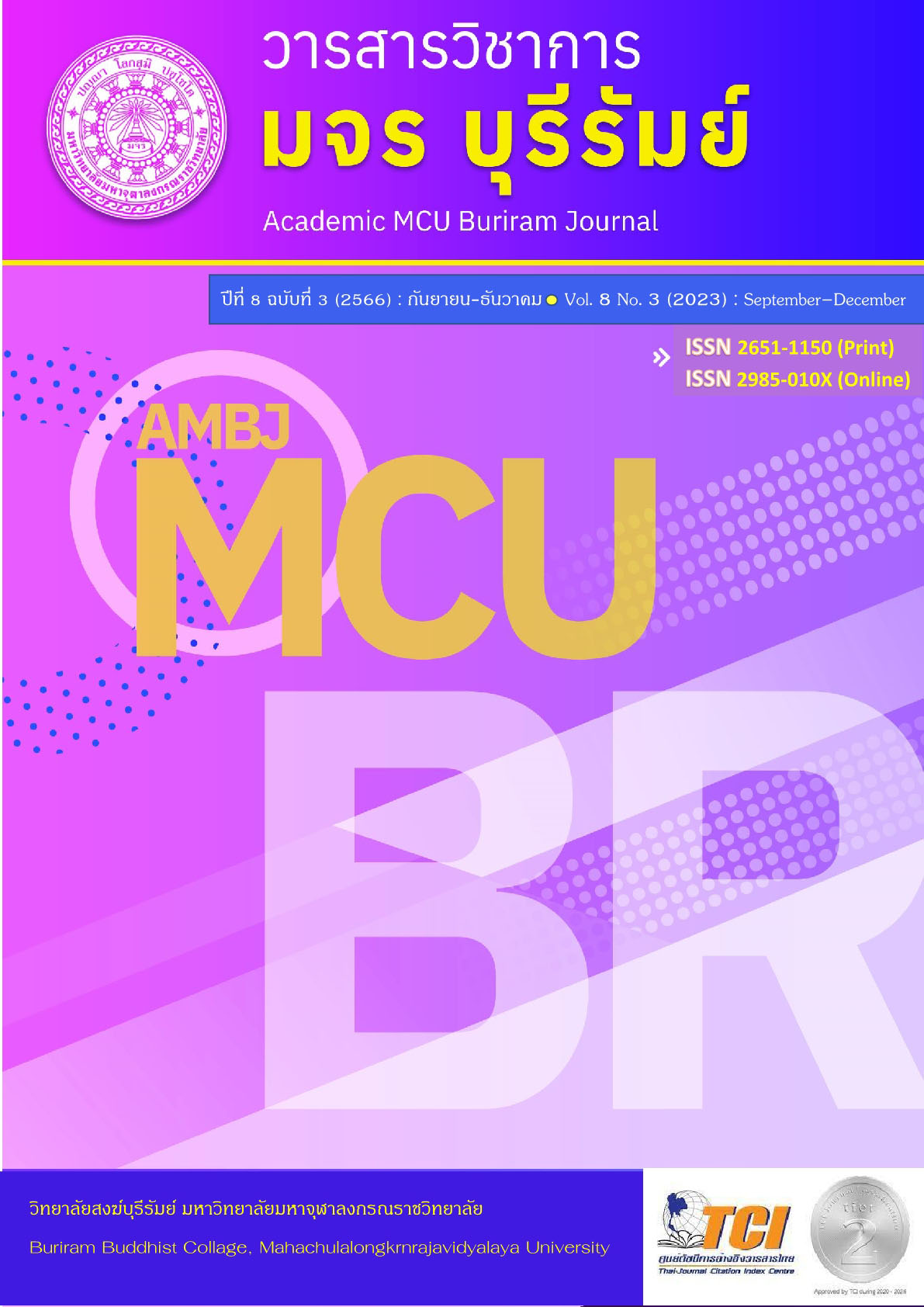Learning Management on the Application of the Concept of Sufficiency Economy Philosophy Social Studies, Religion and Culture Learning Group, Grade 5 by Means of Cooperative Teaching
Keywords:
Learning Management, Sufficiency Economy, Learning Subject Groups, Collaborative TeachingAbstract
The purposes of this research were: 1) study learning management on the application of the concept of the Sufficiency Economy Philosophy. 2) study academic achievement on the application of the concept of the Sufficiency Economy Philosophy. Social studies learning group Religion and culture. 3) Study student satisfaction with learning management. It is a mixed methods research. Using qualitative research methods Quantitative and experimental sample group 22 Grade 5 students. A specific random sampling method took 6 hours to complete. The research tools included observation forms and learning management plans. Academic achievement test and satisfaction questionnaire Qualitative data were analyzed for content analysis. Quantitative data were analyzed using computers. Statistics used in Data analysis included percentages, means, and standard deviations.
The research results found that:
1. Learning management on the application of philosophy concepts sufficiency economy Using cooperative teaching methods the researcher used cooperative learning activities. Teaching and learning activities are clarified. Divide into subgroups Divide duties within the group work together in groups Group presentation Evaluate each other and teachers evaluate learning.
2. Academic achievement the average after studying was higher than before studying. Statistically significant at the .05 level. Score before study was 61.59%, score after study was 89.32%.
3. Analysis of student satisfaction with cooperative learning. It was found that the students were satisfied. The learning process aspect was the most with an average of 4.34, followed by media and learning equipment with an average of 4.31 and the content aspect had an average of 4.24 and the aspect with the lowest average was the measurement and evaluation aspect with an average of 4.17. In summary, students were satisfied at a high level with an average of 4.23.
References
กระทรวงศึกษาธิการ. (2553). หลักสูตรแกนกลางการศึกษาขั้นพื้นฐาน พุทธศักราช 2551. พิมพ์ครั้งที่ 3. กรุงเทพฯ: ชุมนุมสหกรณ์การเกษตรแห่งประเทศไทย จำกัด.
กุลิสรา จิตรชญาวณิช. (2562). การจัดการเรียนรู้. กรุงเทพฯ: สำนักพิมพ์จุฬาลงกรณ์มหาวิทยาลัย.
จันทราภรณ์ คำแก้ว. (2564). การพัฒนากิจกรรมการเรียนรู้แบบร่วมมือเทคนิค TGT เรื่อง พลเมืองดีในวิถีประชาธิปไตย ชั้นประถมศึกษาปีที่ 4. การศึกษามหาบัณฑิต. มหาวิทยาลัยมหาสารคาม.
ชาติชาย ม่วงปฐม. (2557). ทฤษฎีการเรียนการสอน. คณะครุศาสตร์: มหาวิทยาลัยราชภัฏอุดรธานี.
ชมพู สัจจาวาณิชย์. (2553). ผลการจัดการเรียนรู้แบบกลุ่มร่วมมือเทคนิค STAD โดยชุดการเรียน เรื่อง บรรยากาศ กลุ่มสาระการเรียนรู้วิทยาศาสตร์ สำหรับนักเรียนชั้นมัธยมศึกษาปีที่ 1. วิทยานิพนธ์ครุศาสตรมหาบัณฑิต. บัณฑิตวิทยาลัย: มหาวิทยาลัยราชภัฏมหาสารคาม.
นิตติยา กัณหา. (2554). การพัฒนาชุดการเรียนรู้เรื่องศิลปวัฒนธรรมท้องถิ่น จังหวัดบุรีรัมย์กลุ่มสาระการเรียนรู้สังคมศึกษา ศาสนาและวัฒนธรรม สำหรับนักเรียนชั้นประถมศึกษาปีที่ 4. วิทยานิพนธ์ครุศาสตรมหาบัณฑิต (หลักสูตรและการสอน). บัณฑิตวิทยาลัย: มหาวิทยาลัยราชภัฏบุรีรัมย์.
ณิชา โสภณ, ปริญญา ทองสอน และปานเพชร ร่มไทร. (2566). ผลการจัดการเรียนรู้โดยใช้การแสดงบทบาทสมมติ ร่วมกับการเรียนแบบร่วมมือเทคนิคเพื่อนช่วยเพื่อนที่มีต่อผลสัมฤทธิ์ทางการเรียน ทักษะการสื่อสารและเจตคติต่อการเรียนภาษาญี่ปุ่นของนักเรียนชั้นมัธยมศึกษาปีที่ 3. วารสารมหาจุฬาวิชาการ, 10(2),156.
เนาวรัตน์ ศิริรักษ์. (2562). ผลการจัดการเรียนรู้แบบร่วมมือเทคนิค TGT ที่มีต่อผลสัมฤทธิ์ ทางการเรียนและทักษะกระบวนการกลุ่ม เรื่อง เคมีพื้นฐานของสิ่งมีชีวิตของนักเรียนชั้นมัธยมศึกษาปีที่ 4. การศึกษามหาบัณฑิต. มหาวิทยาลัยทักษิณ.
ประดับศิลป์ ชากำนัน. (2556). การพัฒนากิจกรรมการเรียนรู้แบบร่วมมือเทคนิค Learning Together: LT ประกอบหนังสืออ่านเพิ่มเติม เรื่อง หลักธรรมทางพระพุทธศาสนา กลุ่มสาระการเรียนรู้สังคมศึกษา ศาสนา และวัฒนธรรม ชั้นประถมศึกษาปีที่ 3. วารสารมหาวิทยาลัยราชภัฏมหาสารคาม (มนุษยศาสตร์และสังคมศาสตร์), 8(2), 271-279.
ปรียานุช พิบูลสราวุธ. (2556). "ออกแบบการเรียนรู้อย่างไร ให้เด็กเกิดอุปนิสัยพอเพียง” ในปรัชญาของเศรษฐกิจพอเพียง จากหลักคิดสู่วิถีปฏิบัติ. กรุงเทพฯ: มูลนิธิสยามกัมมาจล.
ยุทธณา อาจหาญ. (2551). การพัฒนาบทเรียนอีเลิร์นนิ่ง วิชาฟิสิกส์ เรื่อง แสงและการมองเห็น ชั้นมัธยมศึกษาปีที่ 5. วิทยานิพนธ์ครุศาสตรมหาบัณฑิต. บัณฑิตวิทยาลัย: มหาวิทยาลัยราชภัฏสกลนคร.
โรงเรียนบ้านตึกชุม. (2565). หลักสูตรสถานศึกษาโรงเรียนบ้านตึกชุม. สำนักงานเขตพื้นที่การศึกษาประถมศึกษาสุรินทร์ เขต 2 จังหวัดสุรินทร์.
สิริวรรณ ศรีพหล. (2550). การจัดการเรียนการสอนปรัชญาเศรษฐกิจพอเพียงในโรงเรียน. นนทบุรี: มหาวิทยาลัยสุโขทัยธรรมาธิราช.
สุเมธ ตันติกุล. (2550). การนำเศรษฐกิจพอเพียงมาใช้ในการดำเนินชีวิตและประกอบธุรกิจ. รายการโทรทัศน์. กรุงเทพมหานคร: สำนักนายกรัฐมนตรี.
อัญชลี ประดับ. (2556). ผลการใช้ชุดการเรียน เรื่องการอ่านและการเขียนสะกดคําที่ประสมสระ ลดรูป และสระเปลี่ยนรูป โดยใช้การเรียนรู้แบบร่วมมือเทคนิค LT สำหรับนักเรียนชั้นประถมศึกษาปีที่ 2. วิทยานิพนธ์ครุศาสตรมหาบัณฑิต (หลักสูตรและการสอน). บัณฑิตวิทยาลัย: มหาวิทยาลัยราชภัฏบุรีรัมย์.
Downloads
Published
How to Cite
Issue
Section
License
Copyright (c) 2023 Academic MCU Buriram Journal

This work is licensed under a Creative Commons Attribution-NonCommercial-NoDerivatives 4.0 International License.
ทัศนะและความคิดเห็นที่ปรากฏในบทความวารสารฉบับนี้ถือเป็นความรับผิดชอบของผู้เขียนบทความนั้น ไม่ถือเป็นทัศนะและความรับผิดชอบของบรรณาธิการ





